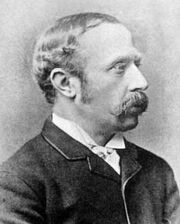
The Whig Party is one of the major political parties in Great Britain. Its origins go back to the English Civil War of the 1640s between the Royalist Party or Cavaliers and the Parliamentary Party or Roundheads. The Parliamentary Party wished to limit the power of the monarchy; when King Charles I resisted their efforts, Parliament ultimately abolished the monarchy. However, a power struggle between the House of Commons and the New Model Army it had raised to fight the Royalists resulted in the imposition of a military dictatorship led by Oliver Cromwell. Cromwell's death led eventually to the restoration of the monarchy, which brought a renewed struggle between absolute monarchists and constitutional monarchists.
During the Exclusion Crisis of the late 1670s, the constitutional monarchists wanted to exclude the Catholic Prince James, Duke of York, from the succession. James' supporters nicknamed the constitutional monarchists "whiggamores," Scottish bandits, which became shortened to Whigs. The Whigs in turn nicknamed James' supporters Tories, Irish Catholic bandits. The effort to exclude James failed, and he succeeded to the throne as King James II. However, the struggle between the two factions continued until the Glorious Revolution of 1688, when James was deposed in favor of his daughter Mary II and her husband William III.
The two factions continued to struggle for control of the government under Mary's sister Queen Anne, and Anne's successor King George I of the House of Hanover. Over the course of the eighteenth century, as the institutions of ministerial government under the Prime Minister evolved, the struggle between the two factions became normalized, and it became accepted that neither would seek to permanently exclude the other from power.
During the American Crisis of the 1760s and 1770s, the two factions divided on the question of how to respond to American resistance to direct Parliamentary taxation, with the Whigs supporting the American position and the Tories opposing it. The policies adopted by the Tory government of Lord North led to the outbreak of the North American Rebellion, when thirteen American colonies attempted to declare independence from the British Empire. This led the American rebels to describe themselves as Whigs and their Loyalist opponents as Tories.
Although the Tories theoretically opposed efforts to limit the powers of the monarchy, Lord North realized that reconciling with the Americans after the Rebellion was put down required him to defy King George III, who opposed his Brotherhood Policy and the Britannic Design. The outbreak of the Trans-Oceanic War in 1795 led Lord North's successor, Sir Charles Jenkinson, to add leading Whigs such as Charles James Fox and William Pitt the Younger to his government, and the distinction between the two parties steadily diminished.
With the issue of the balance of power between Parliament and the monarchy settled, the labels Whig and Tory vanished for a time. The coming of the industrial revolution and the free trade ideas of Adam Smith brought new issues into national politics championed by new Parliamentary factions. These factions called themselves the Liberals and the Conservatives. The Liberal/Conservative era ended with the collapse of Barings Bank on 15 October 1835, which set off a financial panic that ultimately brought down the Liberal government of Lord Thomas Tillotson. A snap election brought a coalition of the Conservatives and the Reform Party to power under the leadership of Lewis Watson.
Within four years, a major shift in the alignments of Parliamentary factions had brought Sir Duncan Amory to power at the head of a revived Tory Party. By the 1880s, the Whig Party had also been revived, and Whig leader Richard Cross led the party to victory over Tory leader Geoffrey Cadogan. Cross went on to win passage of the Great Reform Bill of 1886, which expanded the franchise, redistributed seats in the Commons to better reflect the distribution of population, created a social insurance program, and redistributed equity in large corporations among the British people.
By the 1930s the Tories were back in power under the leadership of George Bolingbroke. By then the overriding issue was growing international tension between Britain and the Germanic Confederation as the two nations competed for resources in Africa and Asia. In the general election held in November 1937, Bolingbroke's Tories defeated Malcolm Hart's Whigs, increasing the likelihood of armed conflict, which came in October 1939 when clashes between British and German troops in Arabia led to the outbreak of the Global War. Although Sobel makes no further mention of party affiliation, it is likely that the Whig and Tory Parties continue to dominate British politics as of the early 1970s.